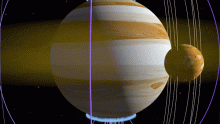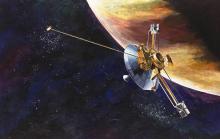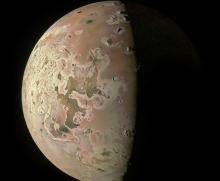Listen to today's episode of StarDate on the web the same day it airs in high-quality streaming audio without any extra ads or announcements. Choose a $8 one-month pass, or listen every day for a year for just $30.
You are here
Moon and Jupiter
The four outer planets of the solar system have a lot in common. They’re all giants — at least four times Earth’s diameter. They’re all made mainly of hydrogen and helium, the lightest elements. They all have lots of moons. And they’re all encircled by rings.
The rings of Saturn are wide and bright, and easily visible through any telescope. The rings of the other giants, on the other hand, are thin and faint. In fact, they’re so faint that they weren’t discovered until late in the last century.
The rings of Jupiter are a case in point. They were discovered in 1979, by a spacecraft that was approaching the planet. In all, scientists have identified four rings, although each of them is made of smaller “ringlets.”
Jupiter’s rings are wider than the distance from Earth to the Moon — wider even than the rings of Saturn. But they contain much less material than Saturn’s rings — widely spread grains of dust.
Most of the dust comes from a few of Jupiter’s moons. Space rocks from outside the Jovian system strike the moons, knocking debris into space. The dust grains eventually spiral inward all the way to Jupiter itself. But more collisions add fresh material — keeping Jupiter’s hard-to-see rings from vanishing entirely.
And Jupiter is easy to spot tonight. It looks like a brilliant star — brighter than any other star or planet that’s visible right now. And it’s quite close to the first-quarter Moon — a beautiful duo in the evening sky.
Script by Damond Benningfield





